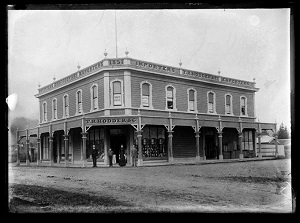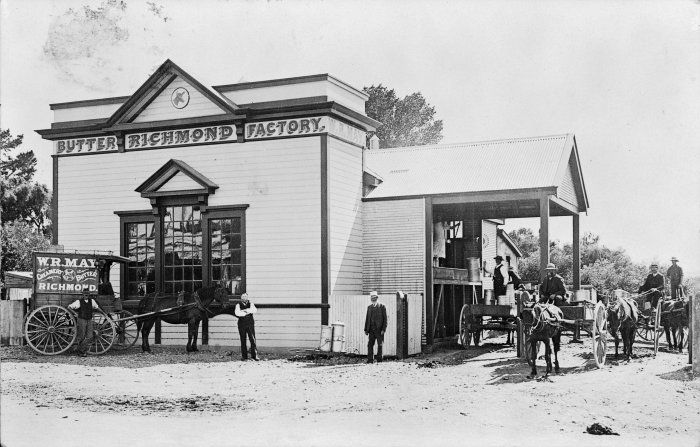May's Retail, Butter and Bacon Empire
May’s Store was a cornerstone of early Richmond, offering everything from groceries and farm supplies to toys and sweets, and providing home deliveries. Established in 1857 by William May and later expanded to included butter and bacon factories.
The Store in Queen Street Richmond
May’s store was an institution in early Richmond. It occupied a large, two-storied building on a prominent site and sold as wide a range of goods as you could get anywhere in the region, from basic groceries, medicines, farm supplies through to toys and sweets – no less than 21 different kinds.
In 1857 the large two-storied general store and drapery opened on the south-east corner of Gladstone Road and Queen Street. The store was operated by Thomas Hodder and George Talbot. A sign identified the building as “Gladstone House”, but it was more often referred to as “Hodder’s Corner”, and later on as “May’s”.
William Richard May purchased the business in 1893 and expanded the range of goods on offer. You could get nearly anything you wanted at May’s – from basic groceries such as flour and eggs, to axes and farm supplies, clothing, crockery, as well as luxuries – including music boxes, dolls and candy.
William’s grand-daughter Muriel recalled: “We had everything there was nothing that we didn’t have or couldn’t get”. “I was able to remember 21 types of sweets … I can’t remember them all now but some of them were frosted caramels, orange and lemon slices – of the jube type; billiard balls – they were too big, they were huge like billiard balls - and acid drops, black balls, brandy balls, peppermints, liquorice all sorts, holiday mixture – great slabs of boiled toffee – you could get a lot for a penny.” Muriel Josephine Canton (William May’s granddaughter).1
“It was always a great adventure when I went into May’s store. The drapery side – I can see it now – they had the wool stacked in partitions and how they could take it out and do up a skein of wool so deftly always amazed me. There always seemed to be wonderful things that you’d see that you wished you could buy and never could.” Elizabeth Maude Sampson.2
Mays even offered a delivery service via horse and cart, so you could have groceries or other goods delivered to your door. Mays employed a large number of workers – including 54 seamstresses in the dressmaking department alone at the turn of the century. That was a huge number at a time when the entire population of Richmond borough was 562.3
In 1944 William sold the business to Les Wells and Joe Hill, who renamed it Waimea Stores and set about modernising parts of the building. From the 1970s, under new ownership, the building housed a variety of businesses, from a second-hand store to a Tattoo and Body Piercing shop, cycle store and, briefly, Radio Fifeshire.
In January 2003 the building was demolished by owner David Lucas, having become increasingly difficult to maintain due to its age.
May’s Butter and Bacon Factories
In 1897 William May decided to expand his business, and built butter and bacon factories, along with a piggery, on the opposite side of the road to the general store.
“Alongside the butcher’s shop, on the left-hand side of Queen Street going up, was May’s cream and bacon factory. The dairy farmers from all around the district brought their cream in large cans by cart to the factory and lined up in a queue at the landing platform to deliver their cream to the vat and afterward go to the steam pipe to clean their cans before returning to their farms.” Roland J Papps.4
William’s grandson, Denis, later remembered having a fine old time in the factories. “The butter factory, which was opposite the shop, used to be one of my favourite playgrounds. There were no safety precautions. I used to go in and turn machines on and turn the steam on that cleaned the tanks out and generally play around without any supervision at all.” Denis May (William May’s grandson).5
Text taken from the May's Store - Queen Street Heritage Board 2017
Updated March 12, 2025
Story by: Tasman District Council & Tasman Libraries
Sources
- Canton, M. J. (1984, June). Interviewed by Slater, L. [Transcript of tape recording]. Richmond Oral History Project, Richmond Borough Council. Richmond, New Zealand. Page 4- 5.
https://heritage.tasmanlibraries.govt.nz/nodes/view/5459 - Sampson, E. M. (1984, May 31). Interviewed by Charters, L. [Transcript of tape recording]. Richmond Oral History Project, Richmond Borough Council. Richmond, New Zealand. Page 12.
https://heritage.tasmanlibraries.govt.nz/nodes/view/5500 - Census returns. (1901, May 1). Nelson Evening Mail, p. 3. Retrieved from
http://paperspast.natlib.govt.nz/newspapers/NEM19010501.2.17 - Papps, R. (1982). Growing up in old Richmond. Reefton, New Zealand: J. E. Smith.
http://www.worldcat.org/oclc/154131030 - May, D. (1984, Jun 1). Interviewed by Charters, L. [Transcript of tape recording]. Richmond Oral History Project, Richmond Borough Council. Richmond, New Zealand. Page 2-5.
https://heritage.tasmanlibraries.govt.nz/nodes/view/5480
Further Sources
Books
- Kepes, A. (Ed.). (1991). Richmond memories. Nelson, New Zealand: June Derecourt Printing Agency.
https://www.worldcat.org/oclc/154642126& - Papps, R. (1982). Growing up in old Richmond. Reefton, New Zealand: J. E. Smith.
https://www.worldcat.org/oclc/154131030 - Sutton, J. (1992). How Richmond grew. Richmond, New Zealand: J. Sutton. p.176-179.
https://www.worldcat.org/oclc/34876506
Newspapers
- Fire at Richmond (1899, May 12). The Colonist, p. 2.
https://paperspast.natlib.govt.nz/newspapers/TC18990512.2.11 - Pioneers of Richmond Business development: Richmond Centennial Sale supplement (1991, July 22). Nelson Evening Mail. p.6.
Websites
- Richmond. (1906). The Cyclopedia of New Zealand: Nelson, Marlborough & Westland Provincial Districts. The Cyclopedia Company Limited, Christchurch, New Zealand. p.124-127.
http://www.nzetc.org/tm/scholarly/tei-Cyc05Cycl-t1-body1-d1-d2-d2.html#name-431503-mention - Richmond Oral History Project. (1983-1984). [transcripts only]. Tasman Heritage.
https://heritage.tasmanlibraries.govt.nz/nodes/view/55 - W. R. May's butter factory, Richmond [Digital Image], (ca 1880s). Manuscripts and Pictorial Collections of the Alexander Turnbull Library.
https://natlib.govt.nz/records/22497444 - Maguire W. T R Hodder Co, Drapers, Richmond [Digital Image] (c1857). Nelson Provincial Museum Photographic Collection. Photographic Reference number 56532.
https://collection.nelsonmuseum.co.nz/objects/63754#.Wjh8HP9OI-M.link

